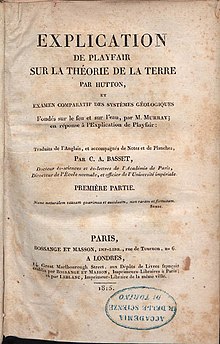John Playfair
John Playfair Playfair (Martian crater) | |
|---|---|
| Scientific career | |
| Fields | Mathematics, natural philosophy, geology |
| Institutions | University of Edinburgh |
John Playfair
In 1783 he was a co-founder of the Royal Society of Edinburgh. He served as General Secretary to the society 1798–1819.[2]
Life
Born at Benvie, slightly west of
Playfair was educated at home until the age of 14, when he entered the
Six years later (1772) he applied for the chair of natural philosophy (physics) at St Andrews University, but again without success. In 1773 he was licensed to preach by the
In 1795 Playfair published an alternative, more stringent formulation of Euclid's parallel postulate, which is now called Playfair's axiom. Although the axiom bears Playfair's name, he did not create it, but credited others, in particular William Ludlam with its prior use.[5]
In 1802 Playfair published his celebrated volume entitled Illustrations of the Huttonian Theory of the Earth. The influence exerted by
He moved from 6 Buccleuch Place to a new house at 2 Albany Street (then called Albany Row) in 1807.[6][7]
Playfair was an opponent of
He died at 2 Albany Street on 20 July 1819. He is buried nearby in Old Calton Burial Ground (a secular burial ground).[10]
Family

Playfair's brothers were architect James Playfair, solicitor Robert Playfair and engineer William Playfair. His nephew, William Henry Playfair (1790–1857) was an eminent architect in Scotland.
In later life he admired and proposed to the wealthy widow Jane Apreece. She turned him down and married Sir Humphry Davy.[11]
He died of strangury on 20 July 1819, and, although an eminent man, was buried in an unmarked grave in Old Calton Burial Ground, on Waterloo Place in Edinburgh. His, and his brother, James's graves were marked by a plaque unveiled in 2011 following a local campaign.[12] The monument to his memory by William Henry Playfair, on Calton Hill,[13] is visible from the spot.
Honours

- Fellow of the Royal Society of Edinburgh
- Fellow of the Royal Society of London, 1807
- Craters on Mars and the Moon were named in his honour.
- The mineral playfairite was named in his honour.[14][15]

Works
- Illustrations of the Huttonian theory of the Earth (in French). London: Pierre François Jean Baptiste Leblanc. 1815.
Critical bibliography
A four-volume collected edition of Playfair's works, with a memoir by James G. Playfair, appeared at Edinburgh in 1822.[16]
His writings include a number of essays contributed to the
His
References
- ^ Playfair, John (1802). Illustration of the Huttonian Theory. Edinburgh: Cadell & Davies – via Internet Archive.
- ISBN 0-902-198-84-X. Archived from the original(PDF) on 4 March 2016. Retrieved 8 January 2018.
- ISBN 090219884X. Retrieved 13 February 2022.
- ^ Morrell, Jack (2004). Playfair, John (1748–1819), mathematician and geologist. Oxford: Oxford University Press.
- ^ J. Playfair and Euclid, Elements of geometry; containing the first six books of Euclid, with two books on the geometry of solids. To which are added, elements of plane and spherical trigonometry, J.B. Lippincott & Co, 1860, p. 291. Available online from Google Books. See also Cajori's A History of Mathematics.
- ^ Edinburgh Post Office Directories 1805 to 1810
- ^ grant's Old and New Edinburgh vol III
- ^ Edinburgh Review, 12, 1808, 120–130
- ^ Smith, Sydney. "Review of Traité de Mécanique Céleste par P. S. Laplace". Edinburgh Review. 11 (22): 249–284.
- ^ Grant's Old and New Edinburgh vol III
- ^ Sophie Forgan, 'Davy, Jane, Lady Davy (1780–1855)', Oxford Dictionary of National Biography, Oxford University Press, 2004; online edn, May 2008 accessed 17 Dec 2014
- ^ "Edinburgh World Heritage - News Article". Archived from the original on 29 August 2013. Retrieved 2 June 2013.
- ^ Biographical Dictionary of Eminent Scotsmen (1856), reproduced in Significant Scots
- ^ Information about Playfairite on Mindat database, Retrieved on 19 April 2012.
- ^ J.L. Jambor (1967) New lead sulfantimonides from Madoc, Ontario; Part 2, Mineral descriptions, Canadian Mineralogist, vol. 9, 194–6
- ^ See the Collected Works of John Playfair on the Internet Archive (www.archive.org)
- S2CID 251576277.
- S2CID 163252270.
External links
- Dictionary of Scientific Biography
- O'Connor, John J.; Robertson, Edmund F., "John Playfair", MacTutor History of Mathematics Archive, University of St Andrews
- Significant Scots: John Playfair
- National Portrait Gallery
- John Playfair (1836) Elements of Geometry from Google books, see page 22 for parallel axiom.
- The works of John Playfair. Edinburgh: A. Constable & Co. 1822. (from HathiTrust)
- From the Linda Hall Library
- Playfair's (1802) Illustrations of the Huttonian Theory of the Earth
- Playfair's (1815) Explication de Playfair sur la théorie de la terre par Hutton
This article incorporates text from a publication now in the public domain: Chisholm, Hugh, ed. (1911). "Playfair, John". Encyclopædia Britannica. Vol. 21 (11th ed.). Cambridge University Press. p. 831.
